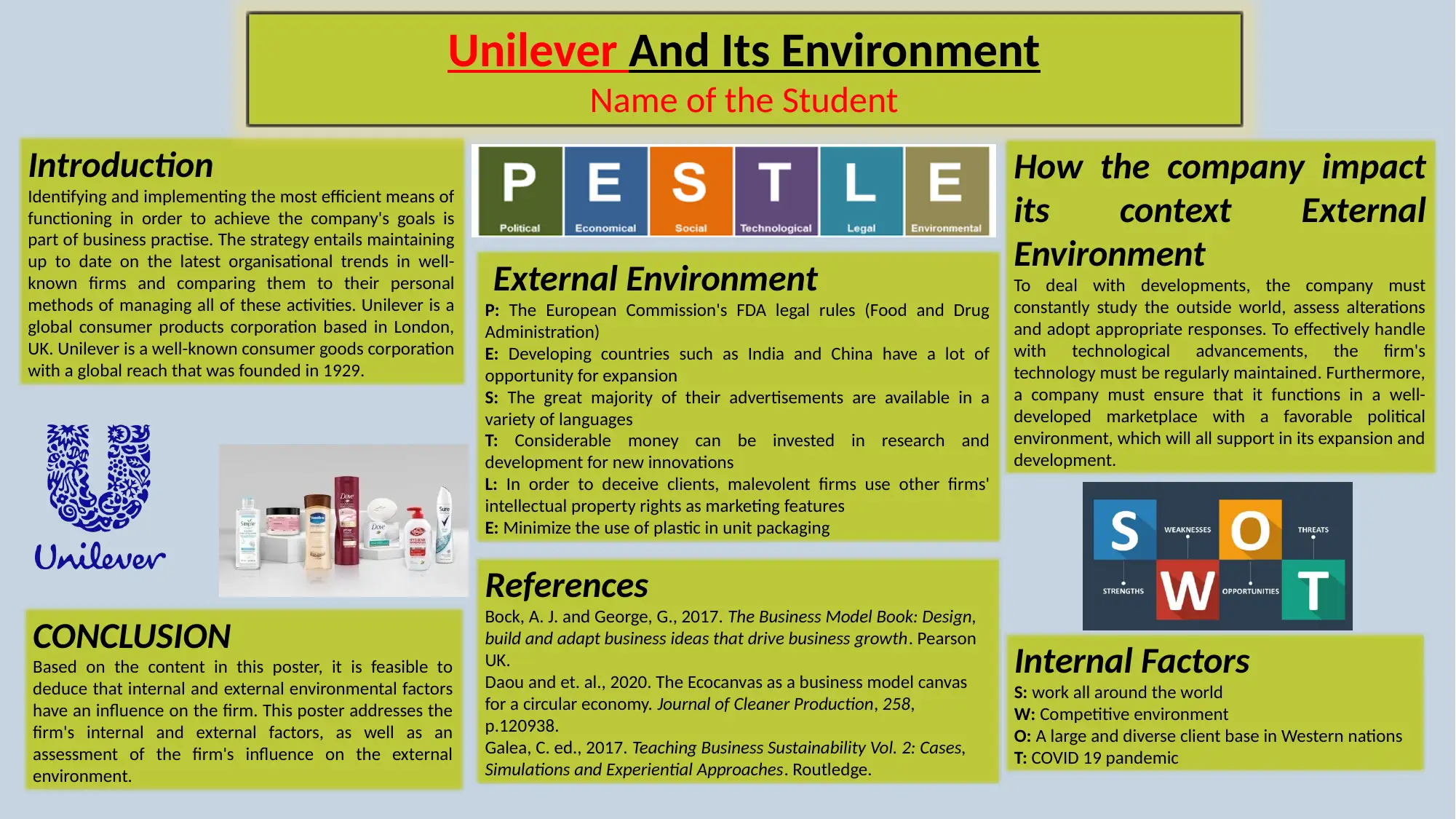Internal & External Environmental Analysis of Unilever BMP3002
VerifiedAdded on 2023/06/18
|1
|422
|325
AI Summary
This poster provides an analysis of Unilever's internal and external environments, examining the factors that impact the company's operations and its influence on the external world. It identifies Unilever as a global consumer products corporation and explores its strengths, weaknesses, opportuni...

Introduction
Identifying and implementing the most efficient means of
functioning in order to achieve the company's goals is
part of business practise. The strategy entails maintaining
up to date on the latest organisational trends in well-
known firms and comparing them to their personal
methods of managing all of these activities. Unilever is a
global consumer products corporation based in London,
UK. Unilever is a well-known consumer goods corporation
with a global reach that was founded in 1929.
Unilever And Its Environment
Name of the Student
External Environment
P: The European Commission's FDA legal rules (Food and Drug
Administration)
E: Developing countries such as India and China have a lot of
opportunity for expansion
S: The great majority of their advertisements are available in a
variety of languages
T: Considerable money can be invested in research and
development for new innovations
L: In order to deceive clients, malevolent firms use other firms'
intellectual property rights as marketing features
E: Minimize the use of plastic in unit packaging
How the company impact
its context External
Environment
To deal with developments, the company must
constantly study the outside world, assess alterations
and adopt appropriate responses. To effectively handle
with technological advancements, the firm's
technology must be regularly maintained. Furthermore,
a company must ensure that it functions in a well-
developed marketplace with a favorable political
environment, which will all support in its expansion and
development.
Internal Factors
S: work all around the world
W: Competitive environment
O: A large and diverse client base in Western nations
T: COVID 19 pandemic
References
Bock, A. J. and George, G., 2017. The Business Model Book: Design,
build and adapt business ideas that drive business growth. Pearson
UK.
Daou and et. al., 2020. The Ecocanvas as a business model canvas
for a circular economy. Journal of Cleaner Production, 258,
p.120938.
Galea, C. ed., 2017. Teaching Business Sustainability Vol. 2: Cases,
Simulations and Experiential Approaches. Routledge.
CONCLUSION
Based on the content in this poster, it is feasible to
deduce that internal and external environmental factors
have an influence on the firm. This poster addresses the
firm's internal and external factors, as well as an
assessment of the firm's influence on the external
environment.
Identifying and implementing the most efficient means of
functioning in order to achieve the company's goals is
part of business practise. The strategy entails maintaining
up to date on the latest organisational trends in well-
known firms and comparing them to their personal
methods of managing all of these activities. Unilever is a
global consumer products corporation based in London,
UK. Unilever is a well-known consumer goods corporation
with a global reach that was founded in 1929.
Unilever And Its Environment
Name of the Student
External Environment
P: The European Commission's FDA legal rules (Food and Drug
Administration)
E: Developing countries such as India and China have a lot of
opportunity for expansion
S: The great majority of their advertisements are available in a
variety of languages
T: Considerable money can be invested in research and
development for new innovations
L: In order to deceive clients, malevolent firms use other firms'
intellectual property rights as marketing features
E: Minimize the use of plastic in unit packaging
How the company impact
its context External
Environment
To deal with developments, the company must
constantly study the outside world, assess alterations
and adopt appropriate responses. To effectively handle
with technological advancements, the firm's
technology must be regularly maintained. Furthermore,
a company must ensure that it functions in a well-
developed marketplace with a favorable political
environment, which will all support in its expansion and
development.
Internal Factors
S: work all around the world
W: Competitive environment
O: A large and diverse client base in Western nations
T: COVID 19 pandemic
References
Bock, A. J. and George, G., 2017. The Business Model Book: Design,
build and adapt business ideas that drive business growth. Pearson
UK.
Daou and et. al., 2020. The Ecocanvas as a business model canvas
for a circular economy. Journal of Cleaner Production, 258,
p.120938.
Galea, C. ed., 2017. Teaching Business Sustainability Vol. 2: Cases,
Simulations and Experiential Approaches. Routledge.
CONCLUSION
Based on the content in this poster, it is feasible to
deduce that internal and external environmental factors
have an influence on the firm. This poster addresses the
firm's internal and external factors, as well as an
assessment of the firm's influence on the external
environment.
Paraphrase This Document
Need a fresh take? Get an instant paraphrase of this document with our AI Paraphraser
1 out of 1
Related Documents
Your All-in-One AI-Powered Toolkit for Academic Success.
+13062052269
info@desklib.com
Available 24*7 on WhatsApp / Email
![[object Object]](/_next/static/media/star-bottom.7253800d.svg)
Unlock your academic potential
© 2024 | Zucol Services PVT LTD | All rights reserved.





